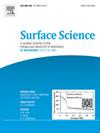Comparative theoretical study of Al- and Ga-doped T-graphene for enhanced NO sensing
IF 1.8
4区 化学
Q3 CHEMISTRY, PHYSICAL
引用次数: 0
Abstract
The development of high-performance toxic gas sensors is critical for environmental monitoring and human health protection. In this study, we present a theoretical investigation into the efficacy of pristine and Al/Ga-doped T-graphene monolayers for nitric oxide (NO) detection. First-principles calculations reveal that pristine T-graphene exhibits limited reactivity and sensitivity toward NO, making it unsuitable for sensing applications. In contrast, Al- and Ga-doped T-graphene demonstrate markedly enhanced NO adsorption, with significantly higher binding energies and substantial electronic property modulations upon gas adsorption. Notably, Ga-doped T-graphene exhibits a strong adsorption energy of –19.20 kcal/mol and a negative Gibbs free energy (–8.39 kcal/mol), confirming spontaneous NO capture with a chemisorption nature. Furthermore, the ultra-fast recovery time (0.01 s) suggests excellent reversibility, positioning Ga-doped T-graphene as a highly promising candidate for practical NO sensing. These findings underscore the potential of doped T-graphene as an efficient, sensitive, and reusable material for next-generation gas sensors.

Al和ga掺杂t -石墨烯增强NO传感的比较理论研究
研制高性能有毒气体传感器对环境监测和人体健康保护具有重要意义。在这项研究中,我们对原始和掺杂Al/ ga的t -石墨烯单层膜检测一氧化氮(NO)的功效进行了理论研究。第一性原理计算表明,原始t-石墨烯对NO的反应性和灵敏度有限,因此不适合用于传感应用。相比之下,Al和ga掺杂的t -石墨烯表现出明显增强的NO吸附,具有明显更高的结合能和大量的电子性质调制。值得注意的是,ga掺杂的t -石墨烯表现出-19.20 kcal/mol的强吸附能和负的吉布斯自由能(-8.39 kcal/mol),证实了化学吸附性质的自发NO捕获。此外,超快的恢复时间(0.01 s)表明其具有优异的可逆性,这使得掺ga的t -石墨烯成为一种非常有前途的实际NO传感候选材料。这些发现强调了掺杂t-石墨烯作为下一代气体传感器的高效、敏感和可重复使用材料的潜力。
本文章由计算机程序翻译,如有差异,请以英文原文为准。
求助全文
约1分钟内获得全文
求助全文
来源期刊

Surface Science
化学-物理:凝聚态物理
CiteScore
3.30
自引率
5.30%
发文量
137
审稿时长
25 days
期刊介绍:
Surface Science is devoted to elucidating the fundamental aspects of chemistry and physics occurring at a wide range of surfaces and interfaces and to disseminating this knowledge fast. The journal welcomes a broad spectrum of topics, including but not limited to:
• model systems (e.g. in Ultra High Vacuum) under well-controlled reactive conditions
• nanoscale science and engineering, including manipulation of matter at the atomic/molecular scale and assembly phenomena
• reactivity of surfaces as related to various applied areas including heterogeneous catalysis, chemistry at electrified interfaces, and semiconductors functionalization
• phenomena at interfaces relevant to energy storage and conversion, and fuels production and utilization
• surface reactivity for environmental protection and pollution remediation
• interactions at surfaces of soft matter, including polymers and biomaterials.
Both experimental and theoretical work, including modeling, is within the scope of the journal. Work published in Surface Science reaches a wide readership, from chemistry and physics to biology and materials science and engineering, providing an excellent forum for cross-fertilization of ideas and broad dissemination of scientific discoveries.
 求助内容:
求助内容: 应助结果提醒方式:
应助结果提醒方式:


